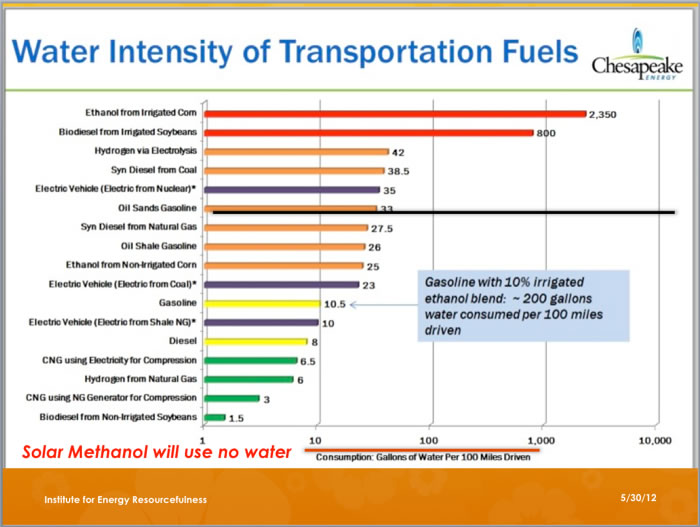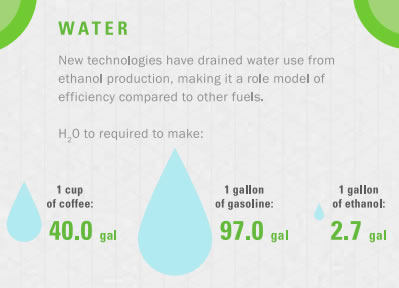Water and Fertilizer Usage in Producing Ethanol Fuels
To produce ethanol, especially in the US, corn is grown and fertilized in 20 states. Corn requires a large amount of water (see chart below). In addition corn is fertilizer intensive. We will discuss these issues below, and compare these resource inputs needed to produce ethanol with the resource inputs needed to produce another alcohol that can successfully be used as a fuel, methanol.
1. US Plants
1.1. Water Usage
The plot below, from Chesapeake Oil and Gas compares the water usage of various fuels. The horizontal axis is logarithmic, meaning every division is a factor of 10 times more than the preceding one. The outstanding usage, of 2,350 gallons needed to make the ethanol required to drive 100 miles is from ethanol. Second, is biodiesel from soybeans, requiring 800 gallons of water/100miles. Together these fuels comprise the majority of present day alternative renewable fuels in the US. To make the comparison clear, gasoline requires 10.5 gallons/100 miles. It's a staggering amount.

The water impacts of biofuel systems must be largely determined within the local contexts (e.g., water availability, the land‐water nexus, and other ecosystem constraints).
Recently the American Coalition for Ethanol published a statistic saying that new technologies have drained water use from ethanol production. Their graphic almost presents a miraculous improvement. Looking at the gasoline numbers in the two charts, we see that 1 gal of water is needed for 10 miles. If average mileage is 25 mpg, then 10/25 = .4 gal gasoline, or 2.5 gal requires 1 gal water. So, there is a large discrepancy between the 97 gal of water for 1 gal shown below. It is unclear where the ACE got its numbers from.

On the other hand methanol made from natural gas (NG) can vary tremendously. If the NG comes from wells, it can be a negligible amount of water per gallon. If the NG is fracked, then 5 million gallons is needed to start the well. However, if the well produces 500 mcf/day, after one year 500 x 365 = 182,500 mcf of NG and at ~ 8gal/mcf we have 182,500 * 8 = 1,460,000 gals of equivalent gasoline energy. Since gasoline per gallon has (114,100/76,100) = 1.5 times the energy of ethanol, this water in one year results in 1460000*1.5 = 2,190,000 gallons of ethanol equivalent. Now we see that, relying on the Chespeake charts, 2350 gallons of water is needed to drive 100 miles. Let's assume that on the energy equivalent basis, a gallon of E85 gets us 20% less mileage than gasoline. So, for a vehicle getting 25 mpg, it will get 20 mpg on ethanol. Thus five gallons are need to go the 100 miles. Thus, 2.28 gal water/gal ethanol means (2.28 gal water/gal ethanol eq.)x (5 gal ethanol) = 11.4 gal of water. This is after 1 year of well operation.
In comparison, the natural gas coming out of a well in ensuing years can be consider water free, or we can amortize the amount of water over the total amount of natural gas over the life of the well. But in any case, fracking for natural gas requires much less water per gallon of energy recovered than by growing corn for ethanol. In fact it requires about the same amount of water as producing a gallon of gasoline.
But even this estimate is not totally right. Since the distillers grain resulting from the feed corn is fed to the cows, some of that water must be assigned to the need to grow that food for the cows.
1.2. Fertilizer usage
2. Brazilian Plants
2.1. Water Usage
2.2. Fertilizer usage
more coming
.


